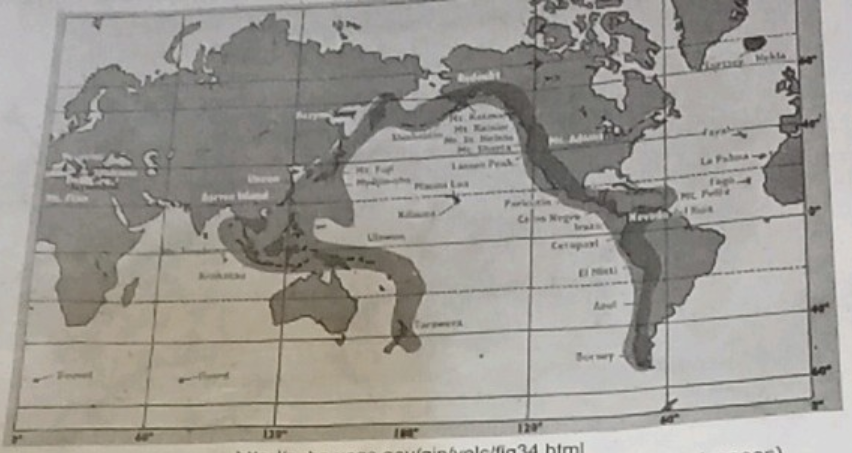
Figure 6. Map of active volcanoos (Red areas represent presence of volcanoes) 2. Study the map of active volcanoes in Figure 6. Q9. How are volcanoes distributed? Q10. Where are they located? Q11. Based on the map, mention a country that is unlikely to experience a volcanic eruption.
Pregunta hecha por un miembro premium de UpStudy a nuestro tutor en vivo.
Solución de tutoría real
Responder
Q9. Volcanoes are distributed along tectonic plate boundaries, often forming a ring around the Pacific Ocean known as the "Ring of Fire."
Q10. They are located primarily around the edges of the Pacific Ocean, in regions such as the west coasts of the Americas, East Asia, Southeast Asia, and the islands of the Pacific Ocean.
Q11. Based on the map, a country that is unlikely to experience a volcanic eruption is Australia.
Solución
Q9. Study the map and note that the red areas, indicating active volcanoes, form a ring around the Pacific Ocean and are present along tectonic plate boundaries.
Q10. Identify the locations of the red areas on the map, which are primarily around the Pacific Ocean, including the west coast of the Americas, East Asia, Southeast Asia, and the Pacific islands.
Q11. Look for regions on the map that do not have red areas indicating active volcanoes. Australia, located away from these red zones, is unlikely to experience a volcanic eruption.
Supplemental Knowledge:
Understanding the distribution and location of active volcanoes is crucial for comprehending geological processes and assessing natural hazards. Let's explore these concepts in detail.
Distribution of Volcanoes:
Tectonic Plate Boundaries:
Most active volcanoes are located along tectonic plate boundaries, where plates converge, diverge, or slide past each other.
The "Ring of Fire," a major area in the basin of the Pacific Ocean, is known for its high volcanic activity due to numerous convergent boundaries.
Hotspots:
Some volcanoes form over hotspots, which are areas where magma from deep within the mantle melts through the crust. Examples include the Hawaiian Islands.
Locations:
Pacific Ring of Fire:
This region encircles the Pacific Ocean and includes countries like Japan, Indonesia, New Zealand, and parts of North and South America.
Mid-Ocean Ridges:
Volcanic activity also occurs along mid-ocean ridges where tectonic plates are diverging. Examples include Iceland on the Mid-Atlantic Ridge.
Other Regions:
Volcanic islands such as those in Hawaii are formed by hotspots away from plate boundaries.
From Concepts to Reality:
Understanding volcanic distribution helps prepare us for disaster and manage risks more efficiently. Here's how this knowledge applies in everyday life:
Disaster Preparedness:
Gaining awareness of volcanic locations allows governments and communities to be better prepared for potential eruptions! Knowing their locations ensures timely evacuations/minimizes losses!
Tourism/Education:
Active volcanoes have long been popular tourist spots. Visitors come to learn about geology while experiencing unique landscapes--boosting local economies in the process!
Volcanic soils can provide rich fertile ground for agriculture! Communities living near volcanoes often reap the rewards from this bountiful resource!
Scientific Research:
Understanding volcanoes deepens our knowledge of Earth's processes! Furthermore, studying them allows us to predict future eruptions/improve safety measures!
These reflections demonstrate how knowledge about volcanoes enriches both personal safety and cultural appreciation!
At UpStudy—we believe mastering geographical skills enriches your learning journey! Explore our live tutor question bank & AI-powered problem-solving services for deeper insights into geography concepts like volcanology!
Revisado y aprobado por el equipo de tutoría de UpStudy
 Explicar
Explicar  Simplifique esta solución
Simplifique esta solución Beyond the Answer
Volcanoes are predominantly distributed along tectonic plate boundaries, forming distinct patterns across the globe. Notably, the "Ring of Fire," a horseshoe-shaped zone encircling the Pacific Ocean, is where most of the Earth's active volcanoes are found, highlighting the powerful geological processes at work beneath our feet and creating a spectacle of nature that can both inspire awe and instill fear. If you look at the map, you will find that countries like Japan, Indonesia, and parts of the United States, especially Alaska and Hawaii, are densely packed with volcanoes. In contrast, countries like Egypt, which lies far from tectonic plate boundaries, are less likely to experience volcanic eruptions, allowing for peaceful pyramids without the worries of sudden lava flows!


